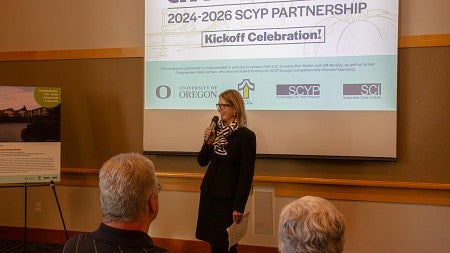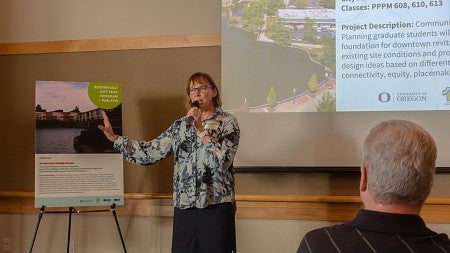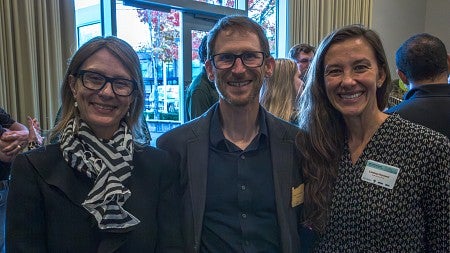
On a bright, sunny October day, the Tualatin Public Library played host to a collection of city officials, faculty, leadership, and community stakeholders to kick-off this year's University of Oregon's (UO) Sustainable City Year Program (SCYP). The year's kick-off offered attendees a preview of the upcoming year's activities and classes for the program's Tualatin partnership. SCYP is a dynamic, cross-disciplinary partnership that brings together students and programs from all over the university to help communities expand their capacity to solve today's problems and develop sustainable frameworks for their future work. Now in its sixteenth year, SCYP continues to leverage its partnerships and resources to great effect as an asset to Oregon's communities and an important piece of the university's and College of Design's (DSGN) strategic goals. Student excitement is at an all-time high as more partners seek help with their projects.

“This partnership goes beyond the college, featuring partnerships between many academic units on campus and even with additional higher education organizations. We are all committed to providing educational experiences that positively impact our community and prepare our students for the workforce. I can confidently say that the Sustainable City Year Program is one powerful, immersive solution to that promise," said Dean Adrian Parr Zaretsky, "SCYP has been helping communities of all sizes for sixteen years with passion, expertise, and energy from students looking to make a difference in the world. I am proud to see the unit continue its storied history of working in partnership with our communities to provide research and academic energy to help provide solutions for these wicked problems. We are excited for this year's projects and I want to thank our dedicated faculty, students, and community leadership for hearing and answering the call to help this vibrant community.”

For this year's engagement, SCYP is matching resources from existing university courses to a number of high-priority projects identified by the Tualatin community, with a particular focus on supporting downtown revitalization efforts. Downtown-focused student projects include a market study, land use planning and design, an examination of connectivity among different travel modes, floodplain research, stormwater management, and architecture design studios, with additional class matches possible throughout the academic year.
SCYP courses will address these project ideas using a cross-disciplinary approach that will include disciplines in business, planning, architecture, and public administration, with more disciplines added throughout this year and courses matched to reflect community priorities. Tualatin officials are excited by the upcoming collaboration.
"The City of Tualatin is galvanized by this year's partnership with the Sustainable City Year Program. As a University of Oregon alumnus, it is incredibly rewarding to have the chance to work with these passionate students," said Sidaro (Sid) Sin, LEED AP, the city of Tualatin's Urban Renewal and Economic Development Manager, "Walking with one of the classes, I was impressed by the students' poise, professionalism, and energy. We are looking forward to the tremendous work they will complete in this service year."
The university's faculty and student resources and expertise help ensure that the mutually advantageous work completed by these classes will give the city a unique opportunity and capacity to address their community's pain points. The backing of a tier 1 research university helps expand the capacity of our local communities to address local issues with access to resources that might not otherwise be available. Thanks to the hard work and support from U.S. Senators Ron Wyden and Jeff Merkley, as well as former Congressman Peter DeFazio, the program and work is supported in part by federal funding secured for SCYP through Congressionally Directed Spending and the US Department of Education. Our elected officials understand the program's importance in improving the lives of all Oregonians, especially dynamic communities like Tualatin.

“We’re excited to partner with the Sustainable City Year Program because it provides the community an amazing opportunity to explore different aspects of the downtown district including design, economic development, sustainability, and community identity while providing students with real-life experience by harnessing their enthusiasm and creativity for problem-solving,” said Frank Bubenik, Tualatin City Mayor.
The partnership officially launched with a celebration dinner in the Tualatin Public Library with remarks given by Tualatin Mayor Frank Bubenik, City Council President Valerie Pratt, Community Advisory Council Member Skip Stanaway, College of Design Dean Adrian Parr Zaretsky, City of Tualatin Urban Renewal and Economic Development Manager Sid Sin, Field Representative Alex O'Keefe on behalf of Representative Andrea Salinas, SCYP Director Megan Banks, and SCI Co-Director and Planning, Public Policy and Management Professor Marc Schlossberg. After the remarks, Tualatin staff and UO faculty took a few minutes to unveil the year’s upcoming projects and share specific partnership details for the stakeholders and personnel at the kick-off.
In addition to the work in Tualatin, SCYP has two Portland-area partnerships with the cities of Estacada and Gladstone, and is also continuing its work with the community of Oakridge. In year two of its first-ever two-year engagement with a city, the program is looking to build off the work and successes of last academic year’s partnership with Oakridge. A few of the ongoing and completed projects included Oakridge Industrial Park marketing and development, Willamette Activity Center planning and outreach, strategies to bring additional tourism to the area, middle housing development planning and design, community service program options, and affordable GIS alternatives for the city.
Sustainable City Year Program
